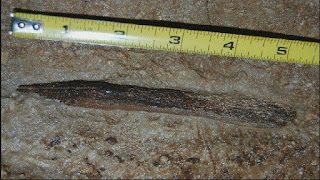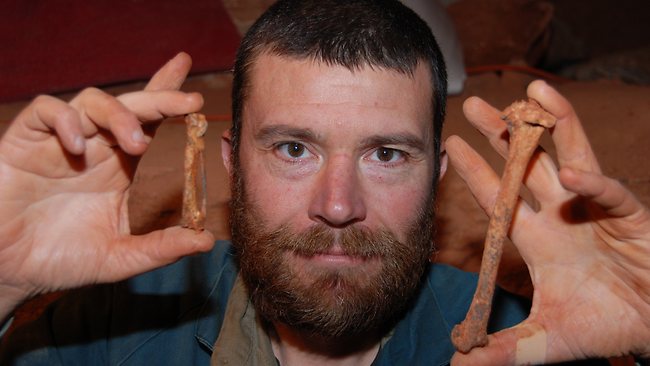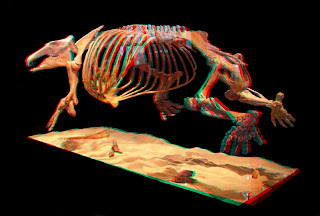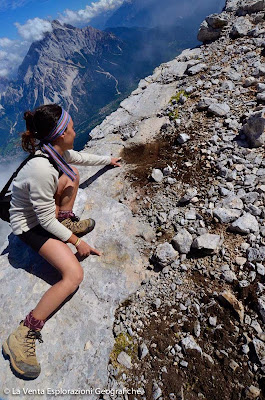A cave littered with the bones of Ice Age creatures will open for the first time to the public on Saturday.
As with many so-called "show caves," Indiana Caverns has the requisite geological formations and a river for subterranean boat rides. But the pre-historic bones — believed to be among the largest cache discovered in one cave — are the "frosting on the cake," says marketing manager Carol Groves.
Located in southern Indiana about 25 miles west of Louisville, the new attraction is part of the 36-mile-long cave Binkley cave system (the nation's 11th longest). Portions have been explored for more than half a century, but the section opening Saturday was only discovered three years ago by a group of caving enthusiasts.
Showing posts with label fossil. Show all posts
Showing posts with label fossil. Show all posts
Tuesday, June 11, 2013
Cave with Ice Age fossils opening in Indiana
Email ThisBlogThis!Share to TwitterShare to FacebookShare to Pinterest
Friday, December 28, 2012
Secret caves in Cape York reveal fossilised snake skeletons and link to Dreamtime
 |
| Model of a giant snake known as a madstsoiid |
Fragments of the giant prehistoric snakes, known by the scientific term madtsoiids, that once stalked the Earth have been found by cavers and scientists in the secret "fossil gold mines" of the state's deep north.
Dated back to the Pleistocene epoch, between 2 million and 11,700 years ago, the fossils are believed to be akin to a constricting python, a predator that grew up to 7m long and as thick as a telegraph pole.
Experts question if the giant snakes intersected with the arrival of the earliest humans and if the extinct creature is the latest clue into the mystery of the popular Dreaming story of Australian Aborigines.
The Rainbow Serpent is a story of creation, where a creature of immense proportions moulded the barren earth into mountains, rivers and gorges as it moved across the featureless land.
Email ThisBlogThis!Share to TwitterShare to FacebookShare to Pinterest
Tuesday, June 12, 2012
Fossil from ancient shark discovered in the Ozarks
 |
| Shark fossils discovered in Smallin Cave |
During tours of Smallin Cave, guides talk about the history of the Civil War, the Indians, even things from the Ice Age like a recently discovered mastadon tooth. Now, paleontologists say, there's a rare find from a 350 million years ago.
It's an endless treasure of beautiful formations and fossils.
"It seems like every day we see something new," said Smallin Cave owner Kevin Bright.
Email ThisBlogThis!Share to TwitterShare to FacebookShare to Pinterest
Sunday, August 14, 2011
Giant bird discovered under Nullabor Plains
 |
| Flinders University palaeontologist Dr Gavin Prideaux with the fossilised bird bones. Pic: Clay Bryce, WA Museum |
Flinders University palaeontologist Gavin Prideaux said the almost complete skeleton was unearthed amid dozens of bird bones in Leaena's Breath Cave in Western Australia, about 70km from the South Australian border.
"We've only ever found one partial eagle fossil before so given how complete this specimen is, it would be an exciting discovery," Dr Prideaux said.
The specimen will be taken to Flinders University to determine if it is an eagle and, if so, whether it is the same species as the modern wedge-tailed eagle or something new.
"It may be new given that it is at least 780,000 years old and probably much older," Dr Prideaux said.
"Surrounding these larger bones are literally hundreds of songbird bones, a situation mirrored through the rest of the deposit.
"This cave has been acting as a bird death trap for at least a million years, which is just one thing that makes this one of the most interesting and unique palaeontological sites in Australia."
The discovery was made during a field trip involving scientists from Flinders University and the Western Australian Museum that is still under way.
Source: Adelaide Now
For more information on this subject you can visit the Flinders Univeristy dedicated website:
http://www.flinders.edu.au/cave/
Email ThisBlogThis!Share to TwitterShare to FacebookShare to Pinterest
Monday, July 25, 2011
Fossils from 'Cradle of Humankind' may be new pre-human species
The birth of our genus has long been a conundrum for paleoanthropologists, to say the least. Only a few scattered and fragmentary fossils older than two million years have been argued to belong to the genus.
Now, the fossil remains found in a cave in South Africa in April 2010 could represent an evolutionary link between apes and our earliest human ancestors.
Lee Berger, a paleoanthropologist at the University of the Witwatersrand, and his colleagues believe the almost-complete fossilised skeleton belonged to an intermediate form between the primitive australopiths and our genus, Homo.
Now, the fossil remains found in a cave in South Africa in April 2010 could represent an evolutionary link between apes and our earliest human ancestors.
Lee Berger, a paleoanthropologist at the University of the Witwatersrand, and his colleagues believe the almost-complete fossilised skeleton belonged to an intermediate form between the primitive australopiths and our genus, Homo.
Email ThisBlogThis!Share to TwitterShare to FacebookShare to Pinterest
Tuesday, June 21, 2011
Extinct sea cow fossil found in Philippines
 The bones of an extinct sea cow species that lived about 20 million years ago have been discovered in a cave in the Philippines by a team of Italian scientists, the expedition head said Monday.
The bones of an extinct sea cow species that lived about 20 million years ago have been discovered in a cave in the Philippines by a team of Italian scientists, the expedition head said Monday.
Several ribs and spine parts of the aquatic mammal were found in February and March in limestone rock above the waters of an underground river on the island of Palawan, said University of Florence geologist Leonardo Piccini.
"The fossil is in the rock, in the cave. We cannot remove it and we don't want to extract it. We would like to wait (for) when the technology will allow us to study the fossil without extracting it," Piccini told AFP.
"The fossil is in the rock, in the cave. We cannot remove it and we don't want to extract it. We would like to wait (for) when the technology will allow us to study the fossil without extracting it," Piccini told AFP.
Email ThisBlogThis!Share to TwitterShare to FacebookShare to Pinterest
Saturday, January 29, 2011
Dinosaur track discovered by cavers on Mount Pelmo, Dolomites
 In September 2011 a group of five speleologists and mountaineers of La Venta Association spotted a possible track of dinosaur footprints at 3025 meters on the North-east ridge of Mount Pelmo in the Dolomites.
In September 2011 a group of five speleologists and mountaineers of La Venta Association spotted a possible track of dinosaur footprints at 3025 meters on the North-east ridge of Mount Pelmo in the Dolomites.Mauro "Lampo" Olivotto, the known sculptor and mountaineer from the Cadore area and author of sculptures known as "Giauli", is the promoter of an extravagant mission suspended among art, mountaineering and poetry: reaching a big cave in the middle of Mount Pelmo's rock face to cast a photographic set for his wooden characters.
The enterprise was accomplished on 10th and 11th September 2011 thanks to four speleologists and mountaineers of La Venta Association of Geographical Explorations. The exploration required establishing a small camp on the north-east ridge of Mount Pelmo, which gave them the time to abseil down to the cavity called the Giauli Cave. This over 150 meter descent down the almost 1000m high face was equipped by speleologist Antonio De Vivo from Treviso.
Email ThisBlogThis!Share to TwitterShare to FacebookShare to Pinterest
Subscribe to:
Posts (Atom)
Showing posts with label fossil. Show all posts
Showing posts with label fossil. Show all posts
Tuesday, June 11, 2013
Cave with Ice Age fossils opening in Indiana
A cave littered with the bones of Ice Age creatures will open for the first time to the public on Saturday.
As with many so-called "show caves," Indiana Caverns has the requisite geological formations and a river for subterranean boat rides. But the pre-historic bones — believed to be among the largest cache discovered in one cave — are the "frosting on the cake," says marketing manager Carol Groves.
Located in southern Indiana about 25 miles west of Louisville, the new attraction is part of the 36-mile-long cave Binkley cave system (the nation's 11th longest). Portions have been explored for more than half a century, but the section opening Saturday was only discovered three years ago by a group of caving enthusiasts.
As with many so-called "show caves," Indiana Caverns has the requisite geological formations and a river for subterranean boat rides. But the pre-historic bones — believed to be among the largest cache discovered in one cave — are the "frosting on the cake," says marketing manager Carol Groves.
Located in southern Indiana about 25 miles west of Louisville, the new attraction is part of the 36-mile-long cave Binkley cave system (the nation's 11th longest). Portions have been explored for more than half a century, but the section opening Saturday was only discovered three years ago by a group of caving enthusiasts.
Friday, December 28, 2012
Secret caves in Cape York reveal fossilised snake skeletons and link to Dreamtime
 |
| Model of a giant snake known as a madstsoiid |
Fragments of the giant prehistoric snakes, known by the scientific term madtsoiids, that once stalked the Earth have been found by cavers and scientists in the secret "fossil gold mines" of the state's deep north.
Dated back to the Pleistocene epoch, between 2 million and 11,700 years ago, the fossils are believed to be akin to a constricting python, a predator that grew up to 7m long and as thick as a telegraph pole.
Experts question if the giant snakes intersected with the arrival of the earliest humans and if the extinct creature is the latest clue into the mystery of the popular Dreaming story of Australian Aborigines.
The Rainbow Serpent is a story of creation, where a creature of immense proportions moulded the barren earth into mountains, rivers and gorges as it moved across the featureless land.
Labels:
Australia,
Chillagoe Caving Club,
fossil,
snake,
Tea-Tree cave
Location:
Townsville Queensland, Australië
Tuesday, June 12, 2012
Fossil from ancient shark discovered in the Ozarks
 |
| Shark fossils discovered in Smallin Cave |
During tours of Smallin Cave, guides talk about the history of the Civil War, the Indians, even things from the Ice Age like a recently discovered mastadon tooth. Now, paleontologists say, there's a rare find from a 350 million years ago.
It's an endless treasure of beautiful formations and fossils.
"It seems like every day we see something new," said Smallin Cave owner Kevin Bright.
Labels:
fossil,
Smallin Cave,
USA
Location:
Ozark Plateau, Verenigde Staten
Sunday, August 14, 2011
Giant bird discovered under Nullabor Plains
 |
| Flinders University palaeontologist Dr Gavin Prideaux with the fossilised bird bones. Pic: Clay Bryce, WA Museum |
Flinders University palaeontologist Gavin Prideaux said the almost complete skeleton was unearthed amid dozens of bird bones in Leaena's Breath Cave in Western Australia, about 70km from the South Australian border.
"We've only ever found one partial eagle fossil before so given how complete this specimen is, it would be an exciting discovery," Dr Prideaux said.
The specimen will be taken to Flinders University to determine if it is an eagle and, if so, whether it is the same species as the modern wedge-tailed eagle or something new.
"It may be new given that it is at least 780,000 years old and probably much older," Dr Prideaux said.
"Surrounding these larger bones are literally hundreds of songbird bones, a situation mirrored through the rest of the deposit.
"This cave has been acting as a bird death trap for at least a million years, which is just one thing that makes this one of the most interesting and unique palaeontological sites in Australia."
The discovery was made during a field trip involving scientists from Flinders University and the Western Australian Museum that is still under way.
Source: Adelaide Now
For more information on this subject you can visit the Flinders Univeristy dedicated website:
http://www.flinders.edu.au/cave/
Monday, July 25, 2011
Fossils from 'Cradle of Humankind' may be new pre-human species
The birth of our genus has long been a conundrum for paleoanthropologists, to say the least. Only a few scattered and fragmentary fossils older than two million years have been argued to belong to the genus.
Now, the fossil remains found in a cave in South Africa in April 2010 could represent an evolutionary link between apes and our earliest human ancestors.
Lee Berger, a paleoanthropologist at the University of the Witwatersrand, and his colleagues believe the almost-complete fossilised skeleton belonged to an intermediate form between the primitive australopiths and our genus, Homo.
Now, the fossil remains found in a cave in South Africa in April 2010 could represent an evolutionary link between apes and our earliest human ancestors.
Lee Berger, a paleoanthropologist at the University of the Witwatersrand, and his colleagues believe the almost-complete fossilised skeleton belonged to an intermediate form between the primitive australopiths and our genus, Homo.
Tuesday, June 21, 2011
Extinct sea cow fossil found in Philippines
 The bones of an extinct sea cow species that lived about 20 million years ago have been discovered in a cave in the Philippines by a team of Italian scientists, the expedition head said Monday.
The bones of an extinct sea cow species that lived about 20 million years ago have been discovered in a cave in the Philippines by a team of Italian scientists, the expedition head said Monday.
Several ribs and spine parts of the aquatic mammal were found in February and March in limestone rock above the waters of an underground river on the island of Palawan, said University of Florence geologist Leonardo Piccini.
"The fossil is in the rock, in the cave. We cannot remove it and we don't want to extract it. We would like to wait (for) when the technology will allow us to study the fossil without extracting it," Piccini told AFP.
"The fossil is in the rock, in the cave. We cannot remove it and we don't want to extract it. We would like to wait (for) when the technology will allow us to study the fossil without extracting it," Piccini told AFP.
Saturday, January 29, 2011
Dinosaur track discovered by cavers on Mount Pelmo, Dolomites
 In September 2011 a group of five speleologists and mountaineers of La Venta Association spotted a possible track of dinosaur footprints at 3025 meters on the North-east ridge of Mount Pelmo in the Dolomites.
In September 2011 a group of five speleologists and mountaineers of La Venta Association spotted a possible track of dinosaur footprints at 3025 meters on the North-east ridge of Mount Pelmo in the Dolomites.Mauro "Lampo" Olivotto, the known sculptor and mountaineer from the Cadore area and author of sculptures known as "Giauli", is the promoter of an extravagant mission suspended among art, mountaineering and poetry: reaching a big cave in the middle of Mount Pelmo's rock face to cast a photographic set for his wooden characters.
The enterprise was accomplished on 10th and 11th September 2011 thanks to four speleologists and mountaineers of La Venta Association of Geographical Explorations. The exploration required establishing a small camp on the north-east ridge of Mount Pelmo, which gave them the time to abseil down to the cavity called the Giauli Cave. This over 150 meter descent down the almost 1000m high face was equipped by speleologist Antonio De Vivo from Treviso.
Subscribe to:
Posts (Atom)

